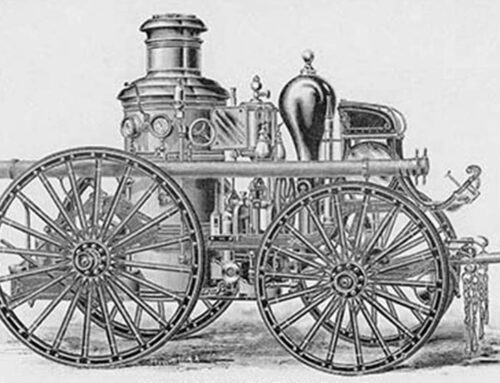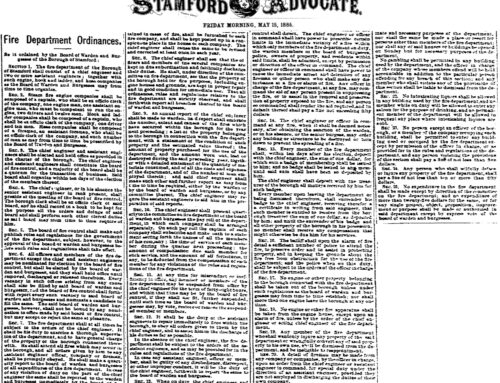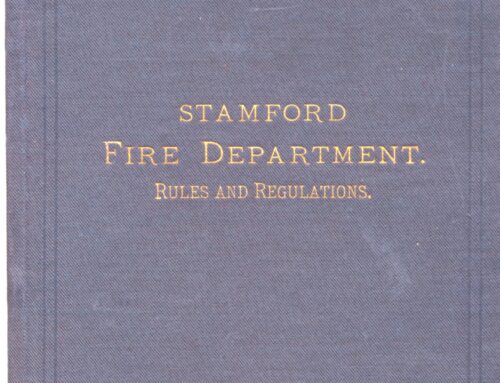On December 20, 1911, Fire & Water Engineering Magazine (now Fire Engineering) published an interesting article about the trials of Stamford’s first motorized pumping engine, an American LaFrance. Lots of out of town guests participated in the trials.
After witnessing an exhaustive demonstration of the powers of the new combination motor engine and hose carriage on the Broad street bridge Saturday afternoon, the councilmen pronounced themselves satisfied with the machine, and it will be put in service as soon as the Stamford firemen are trained to run it. The demonstration was made in the presence of a crowd which contained notables in the fire-fighting line from various parts of this state, besides about 300 Stamford folk. Edward Raymond, expert mechanician of the American La France Company, who delivered the car in Stamford, did his part to perfection and was not troubled with an instant’s delay. The tests resulted as follows:
First test.—-With a line of 300 feet of hose 1 1-8 inch nozzle, at the pump the pressure was 215 pounds, at the nozzle 90 pounds, and 355 gallons of water were pumped per minute.
In the second test. 300 feet of hose, with 1 1-4 inch nozzle, was used. A pressure of 205 pounds was attained at the pumps, 80 pounds at the nozzle, and 412 gallons were thrown out per minute
In the third test, two lines of hose, 300 feet, were used with two nozzles, each 1 1-8 inches. The pump registered 145 pounds pressure, 63 at the nozzle, and 594 gallons were pumped per minute.
The fourth test was with two lines, 300 feet of hose, used Siamese—that is. both hose attached to a one-stream 1 3-8 inch nozzle, and the pumps registered 175 pounds pressure, the nozzle 110, and 588 gallons were thrown out per minute.
In the sixth test, one line. 500 feet of hose, was in use, with a 1 1-8 inch nozzle, and the pumps registered 230 pounds pressure, the nozzle SO. and 335 gallons were pumped.
In the seventh test, one line of hose was used, 500 feet, 1 1-4 inch nozzle. The pumps had a pressure of 250 pounds, the nozzle 60. and 359 gallons per minute was the amount of water pumped.
In the eighth, two lines. 500 feet of hose, were used, Siamese, with 1 3-8 inch nozzle. The pumps had a pressure of 195 pounds, the nozzle 92, and 537 gallous were pumped per minute.
In the ninth, two lines, 500 feet were used, Siamese, with a 1 1-2 inch nozzle. The pressure at the pumps was 175 pounds, at the nozzle 68 pounds, and 550 gallons were pumped per minute.
In the tenth test, two lines, 50 feet were used, Siamese, with a 2-inch nozzle. The pumps brought out 740 gallons of water per minute.
In test No. 11. two lines were used, 50 feet siamese with 1 3-4 inch nozzle. The pressure at tint pumps was 120 pounds, at the nozzle 51, and 650 gallons per minute were pumped.
All of these tests were made from the Rip powam river, where the engine was forced to suck the water from the stream, a distance of over 10 feet, and then force it into the hose. Some of the citizens expressed a desire to see the pumps in action on a hydrant, so the engine was run over to West Park, where an unofficial test was made, 300 feet of hose being used with a I 1-4 inch nozzle, and a pressure of 255 pounds being registered at the pumps. The stream was thrown straight in the air. and went much higher than the highest trees in the park, any of which are as tall as the highest buildings in Stamford. The various tests were recorded by the following officials: At the pumps. Chief Barker. Council man Hart and Master Mechanic Cutler of Hartford: at the nozzles, Commissioner Clark and ssistant Chief Lownis of Hartford. The men representing the American I.a France Company were Messrs. Keating, Jersey and Webber, and Raymond, who run the machine. Some of those present were: Chief Fancher and Commissioner Pierce of New Haven. Deputy Chief Lownis and Commissioners Clark and Dillon, accompanied by Master Mechanic Cutler, from Hartford: Chief Horan of Meriden. Chief Bovardus and a large delegation from South Norwalk. Chirf Wheeler from East Norwalk. Chief Merritt of Greenwich. with a large delegation: Foreman Clark of the Mianus Hose Company, a delegation from Newark, N. J.
— Fire & Water Engineering Magazine, December 20, 1911




